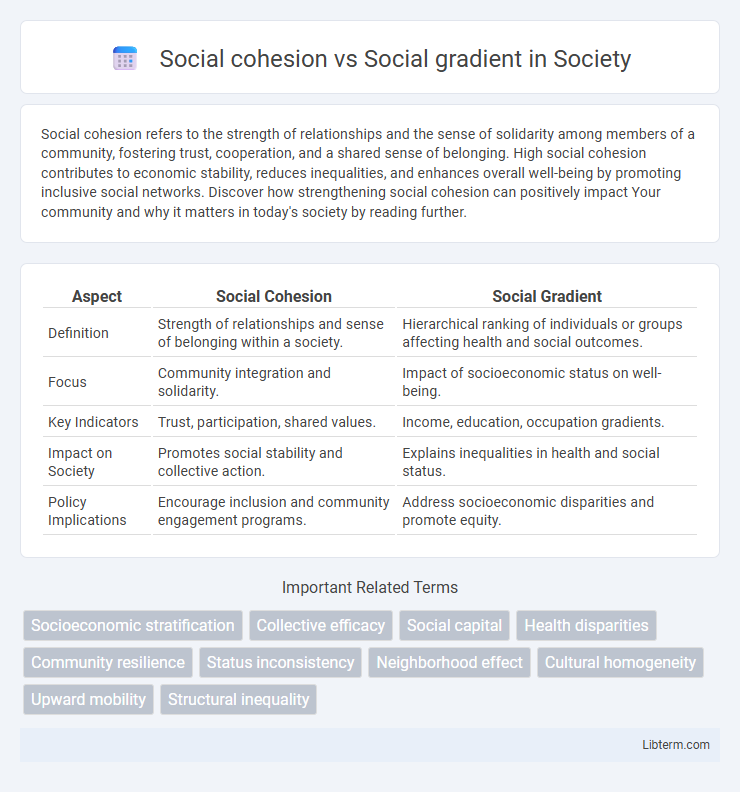Social cohesion refers to the strength of relationships and the sense of solidarity among members of a community, fostering trust, cooperation, and a shared sense of belonging. High social cohesion contributes to economic stability, reduces inequalities, and enhances overall well-being by promoting inclusive social networks. Discover how strengthening social cohesion can positively impact Your community and why it matters in today's society by reading further.
Table of Comparison
| Aspect | Social Cohesion | Social Gradient |
|---|---|---|
| Definition | Strength of relationships and sense of belonging within a society. | Hierarchical ranking of individuals or groups affecting health and social outcomes. |
| Focus | Community integration and solidarity. | Impact of socioeconomic status on well-being. |
| Key Indicators | Trust, participation, shared values. | Income, education, occupation gradients. |
| Impact on Society | Promotes social stability and collective action. | Explains inequalities in health and social status. |
| Policy Implications | Encourage inclusion and community engagement programs. | Address socioeconomic disparities and promote equity. |
Understanding Social Cohesion
Social cohesion refers to the strength of relationships and sense of solidarity among members of a community, fostering trust, shared values, and cooperation. It plays a crucial role in promoting social inclusion, reducing inequalities, and enhancing collective well-being across diverse populations. Understanding social cohesion involves analyzing how social networks, community participation, and mutual support contribute to the stability and resilience of societies.
Defining the Social Gradient
The social gradient refers to the consistent relationship between socioeconomic status and health outcomes, where individuals lower on the hierarchy experience worse health compared to those higher up. This gradient illustrates how social determinants such as income, education, and occupation influence a wide range of health disparities across populations. Understanding the social gradient is essential for addressing inequalities by targeting upstream social factors that shape health trajectories over the life course.
Historical Context of Social Cohesion
Social cohesion, rooted in early sociological theories by Durkheim in the late 19th century, emphasizes the bonds that unite members of a society through shared norms, values, and institutions. Historically, industrialization and urbanization challenged social cohesion by disrupting traditional communities and increasing social fragmentation. In contrast, the concept of the social gradient, developed in public health research, illustrates how health outcomes and social status systematically decline across socioeconomic hierarchies, highlighting persistent inequalities rather than collective unity.
Theories Behind the Social Gradient
Theories behind the social gradient in health emphasize the impact of social hierarchy and relative status on individuals' well-being, highlighting how lower socioeconomic positions correlate with poorer health outcomes. Psychosocial theories suggest that chronic stress from social inequality triggers physiological responses that increase disease risk. Materialist perspectives focus on unequal access to resources like healthcare, nutrition, and safe environments as primary drivers of health disparities along the social gradient.
Social Cohesion’s Role in Community Wellbeing
Social cohesion strengthens community wellbeing by fostering trust, cooperation, and shared values among members, which enhances social support networks and reduces inequalities. Research indicates that higher levels of social cohesion lead to improved mental health, lower crime rates, and greater economic stability within communities. Emphasizing social cohesion can mitigate the negative effects of social gradients, promoting equitable access to resources and opportunities for all individuals.
How the Social Gradient Shapes Health Outcomes
The social gradient in health demonstrates that individuals with lower socioeconomic status consistently experience poorer health outcomes compared to those higher up the gradient, reflecting disparities in access to resources, education, and healthcare. Social cohesion influences health by promoting trust, cooperation, and support within communities, which can buffer some negative effects of social inequalities. However, the pervasive impact of the social gradient reveals that structural factors such as income inequality and occupational status are critical determinants of health disparities across populations.
Intersections Between Social Cohesion and Social Gradient
Social cohesion fosters strong community bonds and trust, which can mitigate the negative effects of social gradients related to income, education, and health disparities. Areas with higher social cohesion often experience reduced social inequalities, as collective support and inclusive networks improve access to resources and opportunities across different socioeconomic groups. Understanding the intersections between social cohesion and social gradient is crucial for developing policies that promote equity and strengthen social well-being in diverse populations.
Policy Approaches: Bridging Social Divides
Policy approaches addressing social cohesion often emphasize community-building initiatives that foster trust, inclusion, and shared values to reduce social fragmentation. In contrast, strategies targeting the social gradient focus on reducing health and economic inequalities through redistributive policies, access to education, and equitable healthcare services. Integrating these approaches requires multi-sector collaboration to create inclusive environments while systematically addressing structural disparities that underlie social divides.
Case Studies: Communities Navigating Both Forces
Case studies reveal how communities navigating both social cohesion and social gradient experience varying outcomes in health, education, and economic mobility. In disadvantaged neighborhoods, strong social cohesion often buffers the negative impacts of steep social gradients by fostering mutual support and collective efficacy. Conversely, low social cohesion in areas with pronounced social gradients exacerbates disparities, highlighting the need for targeted policies that enhance communal bonds while addressing systemic inequalities.
Future Directions in Social Equity Research
Future directions in social equity research emphasize integrating social cohesion metrics with social gradient analyses to better understand health disparities across populations. Emerging studies focus on how enhancing community trust and connectedness can buffer the adverse effects of socioeconomic inequalities. Advancements in longitudinal data and machine learning models offer promising tools to identify causal pathways linking social cohesion and gradients to promote equitable health outcomes.
Social cohesion Infographic

 libterm.com
libterm.com